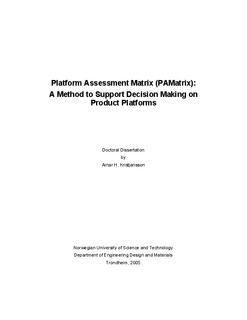| dc.contributor.author | Kristjansson, Arnar Helgi | nb_NO |
| dc.date.accessioned | 2014-12-19T11:25:00Z | |
| dc.date.available | 2014-12-19T11:25:00Z | |
| dc.date.created | 2006-02-15 | nb_NO |
| dc.date.issued | 2005 | nb_NO |
| dc.identifier | 125834 | nb_NO |
| dc.identifier.isbn | 82-471-6944-4 | nb_NO |
| dc.identifier.uri | http://hdl.handle.net/11250/231288 | |
| dc.description.abstract | In the last century there have been drastic changes in the way products are developed and manufactured – manufacturing technologies have advanced and at the same time global competition has increased tremendously. For companies to survive, the name of the game has been to offer greater product variety, in more frequent intervals, and for a lower price. Mass production has been replaced by mass customization, where the basic rule is that the customers should get exactly what they want, at the time they want it.
A partial remedy to concurrently lower cost as well as provide customers with a greater number of variants has been to use platforms*. Platforms in the manufacturing industry have at times been highly advantageous while in other instances they have caused more problems than benefit. Platforms exist in different contexts and scope, and it has been found that companies need to improve their platform management skills in order to increase the general level of competitive advantage.
This dissertation proposes that a company can considerably improve the management of its platforms by increasing its holistic understanding of them. To do this, platforms are viewed from different viewpoints that aim to both display the effect a platform has on its surroundings, as well as the effect its surroundings has on it. This approach has been incorporated into a method called the PAMatrix (Platform Assessment Matrix) that uses a synthesis of cross-functional, subjective expert opinion and consensus based decision making.
The PAMatrix method uses already existing implicit and explicit knowledge to improve decision making on how to manage each individual platform. First a set of platforms are identified that the company views as key enablers for creating a competitive advantage. The platforms are then assessed from several different viewpoints – each capturing a partial evaluation of the platforms’ status or effect. After an assessment of a viewpoint, each stakeholder individually suggests a specific strategic action plan along with a weight factor of how important the viewpoint is to the overall assessment of the specific platform. Finally, the discrete action plan suggestions are collected and jointly assessed and debated – based on which, a final strategic action plan can be made.
The method has been tested in three industrial situations, where its use has been considered beneficial and platform understanding has increased.
* In this dissertation, a platform is defined as the set of core assets that are reused to create a competitive advantage. | nb_NO |
| dc.language | eng | nb_NO |
| dc.publisher | Fakultet for ingeniørvitenskap og teknologi | nb_NO |
| dc.relation.ispartofseries | Doktoravhandlinger ved NTNU, 1503-8181; 2005:39 | nb_NO |
| dc.subject | FORESTRY, AGRICULTURAL SCIENCES and LANDSCAPE PLANNING: Product science | en_GB |
| dc.subject | Produktutvikling | no_NO |
| dc.subject | beslutningsstøttestystemer | no_NO |
| dc.title | Platform Assessment Matrix (PAMatrix): A Method to Support Decision Making on Product Platforms | nb_NO |
| dc.type | Doctoral thesis | nb_NO |
| dc.source.pagenumber | 170 | nb_NO |
| dc.contributor.department | Norges teknisk-naturvitenskapelige universitet, Fakultet for ingeniørvitenskap og teknologi | nb_NO |
| dc.description.degree | dr.ing. | nb_NO |
| dc.description.degree | dr.ing. | en_GB |
